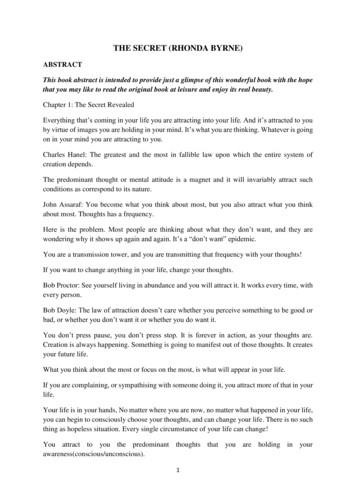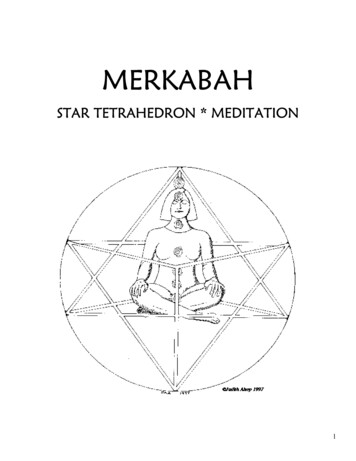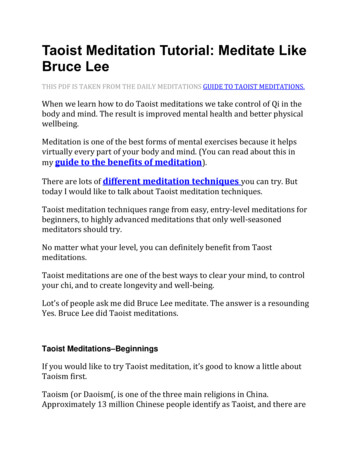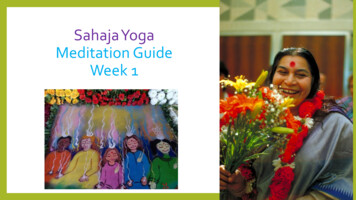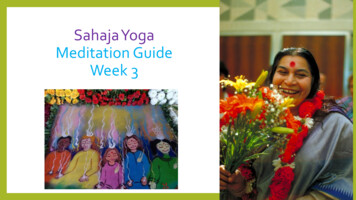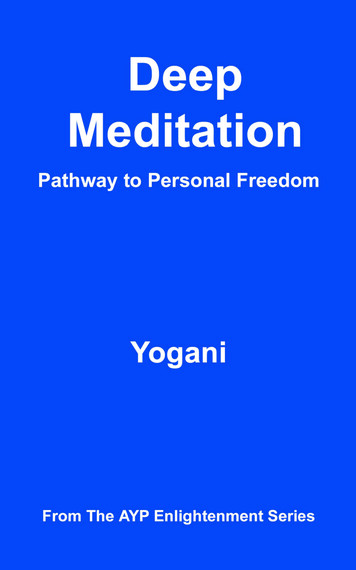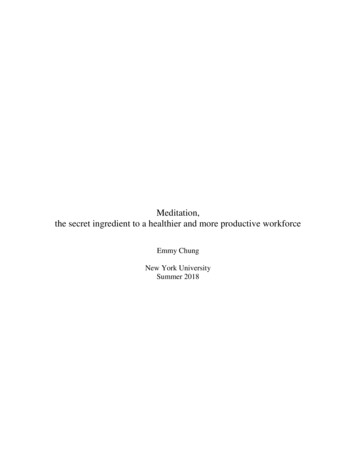
Transcription
Meditation,the secret ingredient to a healthier and more productive workforceEmmy ChungNew York UniversitySummer 2018
I lived in the present, which wasthat part of the future you could see.The past floated above my head,like the sun and moon, visible but never reachable.—-Landscape by Louise GluckIntroduction: Unlocking Talents’ PotentialWith the massive information intake as well as the rapidly changing environment, it isincreasingly difficult for leaders and talents to not be overwhelmed and burn out. Likewise,organizations would require more decision making and analysis to conduct business activity. Butwhat is the best way for companies to utilize their talents? Is it possible to increase one’sproductivity? Is it possible to further develop an adult’s brain? The answer is yes to all of thequestions if one practices meditation. Meditation involves objectively observing the mind’s trainof thoughts. Existing studies proved that practicing meditation has a variety of neurologicalbenefits – “from changes in grey matter volume to reduced activity in the “me” centers of thebrain to enhanced connectivity between brain regions” (Walton, 2018). Meditation has becomemore popular in multinational companies, like Google, Apple, and Target, as they haveintegrated the practice into the company’s culture (Walton, 2018).Therefore, this research paper will investigate how meditation could be a solution in improvinglabors’ wellbeing and work performance, and thus indirectly result in the increase inorganizational profit. The paper will first analyze the problem, stress, that workers encounter,and how is it a leading factor that affects performance. Then propose meditation as the solutionby providing an overview of different types of meditation as well as an analysis of theadvantages and disadvantages. In order to evaluate the effectiveness of meditation, I will discussmy first-hand meditation experience, and also find five subjects to participate in the study. Thefive subjects are working in different roles and industries, but are also under stress. Lastly, anoriginal solution will be recommended to customize a solution not only for the participants of thestudy but also for anyone else who is interested in starting their meditation journey.The reason that I wanted to research this topic is that I have always been fascinated byneuroscience and psychology. I was also really interested in learning about Chakras, energy, andhoroscope when I was young. Although many of these are unexplainable, I know that they existin our life. My mother’s Buddhist religious background also contributed to building my interestin meditation. All of these are abstract concepts that can influence our behaviors and wellbeing. Ipersonally have been through a meditation camp and felt the difference in increase attention.Furthermore, I have also been to the mindfulness boot camp developed by Google. I am awarethat I am more mindful of many aspects of the life of which made me able to view situations in amore objective way. Meditation can help reduce stress and relieve depression. Therefore, I feellike it should be a program that should not only be popular among large corporations, religiouspractitioners or yogis. If I am capable to provide more pieces of evidence of the positive effectsof meditation and how it can help develop the brain. I hope to promote meditation practice to
everyone by making it become an everyday habit for everyone just like showering and eating.Meditation can be integrated into schools as a ten minute assemble activity, or be integrated intocompanies during lunch hour. This not only will aid companies to perform better due toemployees with stronger mental health, but also a healthier labor force in general.Stress is caused by being ‘here’, but wanting to be ‘there’.— Eckhart TolleProblem: Is Our Natural Instinct Killing Us?Human’s natural instinct helps to protect us and keep us alive, our fight or flight response will betriggered when we encounter any potential threats. As a result, “our sympathetic nervoussystem is activated leading to the production of catecholamines, adrenaline and noradrenaline”that prepares the body to respond to the situation (Novais et al., 2017). However, when beingexposed to chronic stress, these responses have detrimental effects on our mental and physicalhealth. The brain undergoes structural and functional changes, particularly in the hippocampus,amygdala and prefrontal cortex, that translates into behavioral dysfunction (Novais et al., 2017).Hippocampal dendritic atrophy was observed after chronic stress that triggered “the loss ofsynapses and impaired the long-term potentiation in the brain region”, which correlates with“impairments in learning and memory” (Novais et al., 2017). Likewise, there is a decrease insynaptic plasticity in the PFC, which was shown to “affect the hippocampal-PFC pathway, byreducing the LTP response that disrupts working memory and behavioral flexibility, a well asattention task switching” (Novais et al., 2017). Similarly, in the amygdala, “neurons exhibitenhanced dendritic arborization and spine density in response to chronic stress”, which "havebeen associated with increased emotional behavior such as anxiety and fear” (Novais et al.,2017). These effects to the brain cause noticeable stress-related symptoms including “chronicmusculoskeletal pain, sleep problems, lethargy and fatigue, depression, anxiety, headache,gastrointestinal complaints, and cardiovascular symptoms” (Greeson et al., 2018)Can one’s stress influence others? A study led by Toni-Lee Sterley of the Hotchkiss BrainInstitute revealed that “transmission from the stressed subject to the naive partner required theactivation of paraventricular (PVR) and corticotropin-releasing hormone (CRH) neurons in bothsubjects and partners to drive and detect the release of a putative alarm pheromone from thestressed mouse” (Sterley et al., 2018). Surprisingly, the “transmitted stress has the same lastingeffects on glutamate synapses as authentic stress” (Sterley et al., 2018). In the study, Sterley andhis team observe the brain’s response of a pair of mice, one exposed to stress while the other hadnot. The results show that “the stressed mouse experienced changes in a group of neurons locatedin the hippocampus, a brain area that plays a central role in memory and emotional response. Thebrain of the other mouse that hadn’t been stressed, but was now in the presence of its stressedpartner, rapidly showed the same neuronal changes in its hippocampus” (DiSalvo, 2018).Although this study was conducted on a mouse, the fact that human also has PVR and CRHneurons that are responsible to activate the transmission of stress means that this result is also
applicable to human. The study shows that simply being surrounded by a stressed individualwould be sufficient to receive transmitted stress. This result provides an important implicationfor the workplace. It shows that if people in an organization are under stress, it will not onlyimpair the performance of the stressed individual but also has a spillover effect to affect others.Is stress only caused by external factors? Interestingly, Tracy Bale, professor of neuroscience inPenn’s School of Veterinary Medicine and Perelman School of Medicine discovered that “alifetime of mild stress in male mice can change specific epigenetic makers in their sperm toshape brain development and impair the stress response of their offspring” (Paddock, 2018). Thisis because, there is a “biological mechanism that allows changes in the father's microRNA to bepassed onto his offspring”, and these “microRNAs ultimately influence gene expression in theoffspring” (Paddock, 2018). Furthermore, Studies found that there is “an association betweenmaternal exposure to different stressors during pregnancy and an increased susceptibility of thechild to develop emotional and cognitive disorders, such as attention deficits, anxiety andlanguage delays” (Novais et al, 2017). Prenatal stress has different effects on male and female.Prenatally stressed males “exhibit impairments on learning-induced neurogenesis, and reducedhippocampal long-term potentiation (LTP), together with increased long-term depression (LTD)”(Novais et al., 2017). While prenatally stressed females “are more susceptible to a dysfunctionalemotional behavior exhibiting an increase in anxiety and depressive-like behaviors” (Novais etal., 2017).I have been one acquainted with the night.I have walked out in rain—and back in rain.I have outwalked the furthest city light.I have looked down the saddest city lane.I have passed by the watchman on his beat.— Robert Frost, 1874 - 1963, “Acquainted with the Night”Solution: The Art of Being PresentIn the modern society, people are so busy with lives that they often rush through moments. It isreally difficult to live in the present moment, especially for people living in the city. There aredefinitely times when one is simultaneously rushing to catch a bus and chewing on theirbreakfast while practicing a presentation script in his/her head. Robert Frost’s excerpt of how “I”objectively noticed "my" behaviors and actions remind the reader to pause and enjoy themoment. Instead of rushing into decisions quickly and reacting to stimulus immediately,sometimes it would be beneficial to take a step back to evaluate problems in a larger context.Therefore, being mindful is especially essential for leaders and employees who make decisionson behalf of organizations. This could be done through meditation.There are five main types of meditation:
1. Spiritual MeditationSpiritual Meditation is the basis for many ancient traditions including, Buddhism, Hinduism,Taoism, and Christians as it includes an aspect of divine connection (“A Brief History ofMeditation” 2018). Yet, the aim of this type of meditation is to focus on self-actualization andawakening.2. Mindfulness MeditationThe mindfulness meditation was derived from Buddha’s methodology. Mindfulness helps toachieve happier and more grateful lives through overcoming negative experiences,acknowledging the reality, and recognizing without judgment.3. Movement MeditationThis type of meditation emphasizes the awareness of the physical body in motion. Particularly inyoga, tai chi, and martial arts, they all integrate the body awareness and deep breathing techniqueof meditation. The movement meditation serves as a bridge to gap meditation practice to ourdaily lives (“What Are the Different Types of Meditation? Forms Techniques & Benefits,2018”). After one master how to be present in his/her body, it could be applicable to any dailytask, from walking, eating, gardening to talking.4. Visualization MeditationOriginated from the Tibetan tradition, this practice requires summoning an image associated withparticular experience, feelings, and thoughts in mind. The practitioners would try to experiencetheir sensations and thoughts again with the aim to detach them from themselves and achievepeacefulness in their minds (“What Are the Different Types of Meditation? Forms Techniques &Benefits, 2018”). This style requires a skillful instructor to guide the process as practitionerscould excessively dwell into memories and/or fantasize the future.5. Chanting MeditationMany religions include chanting in their meditation practice. The practitioner focuses on thesounds and melody. It is believed that the chants could help to “clear the mind and allow ourspiritual strengths to reveal themselves (“What Are the Different Types of Meditation? FormsTechniques & Benefits, 2018”). Qualified teachers would be essential to guide the practitioner inchanting.All of these types of meditations are not mutually exclusive, one may shift their types throughouttheir practice in a single setting or even just simultaneously perform few types together. Yet,understanding the different types can enable the practitioners to be more aware of the best typethat suits them. For instance, for someone who is impatient, movement meditation might be themost appropriate method to begin his/her meditation journey. He/she can later then try toconcentrate particularly on the focused meditation as a means to overcome their impatience. Thiswould make meditation more adaptable to different needs while maintaining the essence ofmeditation.To start off the meditation journey, mobile phone application, such as Simple Habit, can be usedto aid beginner in practicing mindfulness meditation. In Simple Habit, there is an option to
meditate “on the go”. This allows users to select the time, mood and event happening at thatmoment as a means for users to access meditation effortlessly anytime and anywhere, therebyenabling users to easily incorporate meditation into their lives. No matter when the user is feelingnervous, commuting, or overthinking, there are different meditation narrative that specificallyaddresses the user’s circumstance.Studies have found that that mobile phone application could have a better effect than thetraditional meditation method. A research published in the “Journal of Occupational HealthPsychology” shows that “short guided mindfulness meditations delivered via smartphone andpracticed multiple times per week can improve outcomes related to work stress and well-being,with potentially lasting effects” (Bostock et al., 2018). The “participants were 238 healthyemployees from two large United Kingdom companies that were randomized to a mindfulnessmeditation practice app” or controlled group without the app of meditation recordings (Bostocket al., 2018). During the study, participants were asked to complete one meditation per day,chosen from “45 prerecorded 10- to 20-min guided audio meditations” (Bostock et al., 2018).Eight weeks into the study, the group using smartphone’s app “reported significant improvementin well-being, distress, job strain, and perceptions of workplace social support compared to thecontrol group. In addition, the intervention group had a marginally significant decrease in selfmeasured workday systolic blood pressure from pre- to post-intervention” (Bostock et al., 2018).As a result, the 16-week follow-up assessment shows that sustained positive effects can occur tothe subjects’ well-being and job strain by using smartphone app meditation guidance.Furthermore, there is another study on novice pediatric nurses conducted by researchers at theUniversity of Southern California. The result is that the group of nurses who uses smartphoneapp has “significantly more acting with awareness and marginally more non-reactivity to innerexperience” skills compared to the group that did not (Morrison et al., 2018). It also found that“the smartphone intervention group also showed marginally more compassion satisfaction andmarginally less burnout. Additionally, they “had a lower risk for compassion fatigue” compare tothe other group (Morrison et al., 2018). However, this is “only when the nurses had sub-clinicalpost-traumatic symptoms at the start of the residency training program”, hence signifying that“the smart-phone intervention may be better indicated for nurses without existing symptoms ofpost-traumatic stress” only (Morrison et al., 2018).Although both studies show that smartphone app meditation guide could generally help withdecreasing burnout and job strain while improving ones’ well-being and compassion satisfaction.The results also show that people with symptoms of post-traumatic stress might not receivebenefit from it.Moreover, there are also other alternatives. One can participate in meditation retreats or programfor a more immersive and insightful experience. For instance, Chade-Meng Tan, a Google’s exengineer, developed a training program, Search Inside Yourself (SIY), for “individuals andorganizations to sustain peak professional performance with ease, grace, andcompassion”(“About”, 2018). Tan established the “Search Inside Yourself Leadership Institute”which aims to cultivate leaders through mindfulness and meditation techniques (“About”, 2018).
I was fortunate enough to experience the Search Inside Yourself training program first hand. Theentire training process involved simple exercises. The warm-up exercise was to pair up with apartner and listen to the other person without judgment. Often times we have the tendency tothink what to respond in advance or interrupt the other person without actually mindfullylistening to them. The practice made me more focus on the person speaking. Then we haveexercises that have us recall emotions. The purpose was to detach ourselves from our emotions,and merely acknowledge what we were feeling. That enabled us to pause before reacting as ameans to handle emotions in a controlled manner. There was another really easy exercise that Idid not realize its importance until I have experienced it myself. The instructor simply asked usto close our eyes, listen to our surroundings and feel our bodies. When I do that I instantlyrealized how I unconsciously tense up my neck and shoulders. I have always had chronic neckand shoulder pain, but had failed to discover the underlying causes. After the workshop, I feltvery different from how I see the world. Instead of being immersed in my daily routines, I amable to experience the world in a more objective way as if I am witnessing what is happening inreality.Like me, many participants feel the advantage of the program. The SIY program yield positiveresults from “450 participants across 37 programs in more than 14 countries” after comparing thedata of the same assessment before and after the training program (“Measuring Success: SIYLI'sImpact in 2017”, 2018). Participants feel that their focus increased, since 64% more participantsagree that they are “able to notice when [their] attention [have] been pulled away and return it tothe present moment” (“Measuring Success: SIYLI's Impact in 2017”, 2018). Likewise, there is a52% decrease in participants who "feel so distracted that [they] have difficulty sorting out whatis essential from what is unnecessary” (“Measuring Success: SIYLI's Impact in 2017”, 2018).Furthermore, mindfulness practice decreases stress since there are 86% more participants agreethat they “use a deliberate technique to calm [themselves] when [they are] in the middle of astressful situation” (“Measuring Success: SIYLI's Impact in 2017”, 2018). Resilience alsoincreased as 56% more participants “feel that [they] can bounce back quickly after anemotionally challenging situation” (“Measuring Success: SIYLI's Impact in 2017”, 2018). Inaddition, according to the survey results conducted by Institute for Mindful Leadership, “93% ofleaders reported that mindfulness training helped them create space for innovation” and “nearly70% said it helped them to think strategically” (“Mindful Leadership Research Results”).The effects on individuals have significant positive spillover effects on their work andorganization performance. For instance, Aetna, an insurance company implemented mindfulnessbased programs in the organization, which resulted in 13,000 employees “regaining 62 minutesper week of productivity with an approximate dollar return, in terms of productivity alone, ofmore than 3,000” (Bertolini, 2014). Furthermore, Barry Margerum, the Chief Strategy Officerof Plantronics, said that mindfulness practice helped “improve the way their team workstogether, enhance their innovative thinking and clarity, reduce stress, improve general wellbeing, manage difficult conversations, and be generally more at peace” (“About”, 2018).Changes can be experienced in a short amount of time. For instance, the research conducted byHülsheger shows that merely two weeks of mindfulness practice increased well-being, decreasedemotional exhaustion, and increased job satisfaction (Hülsheger, et al 2013). Therefore, thesepieces of evidence illustrate that meditation practice improves the individual well-being of whichhas a positive effect on improving performance in the workplace.
Although meditation practice has a lot of renowned advantages. There are also dangers that haveto be known before practicing it in order to ensure that the practitioner can enjoy the benefits ofmeditation. Often times, beginners start to meditate because they wish to seek the peaceful andepiphanic state in mind. Yet, this would defeat the primary aim of meditation which is tomindfully and objectively observe oneself (Frey, 2016). When one wants to chase after insightsand perspectives, it would immerse the practitioner into the moment and cloud their judgmentswith subjectivity. This would then triggers unwanted negative emotions, such as disappointment,frustration, and unhappiness, due to the inability to achieve the stage that one expected (Frey,2016). Therefore, it is important to maintain awareness at each moment, no matter it is in ourthoughts, emotions, body or the environment.Meditation practice’s ultimate goal is for one to be mindful of oneself. Hence, rather than merelythirty minutes of deep breathing or yoga session, one should learn to acquire the skill of being inthe present as a way of living. This can help us manage many unwanted situations. For instance,when feeling stressed or unmotivated, the individual should acknowledge that it is merely afeeling (Ivtzan, 2016). This way the individual can detach herself/himself from the emotions andmove on from them. However, there could be a danger here. As a beginner, it is really difficult todetermine and handle the emotions in a way that one wants. The practitioner could haveunconsciously buried their negative emotions, and thus creates adverse effects (Ivtzan, 2016).The non-attachment could cause one to avoid the situations, repress emotions or even beindifference to their surroundings (Ivtzan, 2016). Also, when the practitioner wants to cry orfeels angry, it could be more useful to relief those negative emotions through other means.Meditation is certainly merely one out of many methods that someone can use to manage theiremotions. It should be complemented with other methods, including exercising, crying, talking tosomeone, finding a psychologist or taking medications.Problems can be experienced as. a chance for renewal rather than stress.— Marilyn FergusonSubjects’ Role & SituationSubject 1: CEO of Hong Kong United Overseas BankRole & Situation – As the CEO of the company, Subject 1 has to constantly travel to differentcountries to host meetings, attend conferences and negotiate deals. The past week, she eventraveled to three countries within 48 hours. Being the head of the organization is significantlystressful as the organizations’ future and revenue depend upon every decision she makes. Shementioned that she has no break at all. She usually takes public transportation, likeMTR/subway, instead of private cars, because traffic wastes her time. Every gap she has whenshe is not with clients or colleagues, she finds herself to be replying to emails.
Why does the Subject want to participate? – She feels like this lifestyle is not sustainable as shecould soon burn out, yet she has to continue her job as a CEO. Also, she realized that there is anegative decline in her mental acuteness. Therefore, she wants to learn how to take a break andreduce stress. After understanding the benefits of meditation, she wants to give it a try. As shethinks that even if there are no significant positive effects like how she anticipated, there is stillno harm to let her brain pause for 10 minutes every day. If there are positive effects, then shewould hope to make meditation a lifestyle as a means to reach her potential.Subject 2: An Executive Director at Henderson Land Development CompanyRole & Situation – Subject 2 is currently the lead for a major project for the Hong Konggovernment. The project is to create a park in Hong Kong to advocate the Arts and culture. Thisproject has already been ongoing for five years, yet now the completion date has been postponedand the project went over-budget. He mentioned that the media and news are criticizing theproject planning, the shareholders are complaining, and the government is also questioning.Pressures from different stakeholders make him feeling constantly stressed.Why does the Subject want to participate? – He is currently experiencing severe stress andinsomnia. Medication was not very helpful. He also wants to find a natural healthier alternativeto fix his sleeping problem. He hopes that meditation can relieve his stress and enable him tomake better decisions with increased focus and clarity.Subject 3: Senior Manager at AIA Insurance CompanyRole & Situation – As a senior manager at AIA, Subject 3 constantly have to meet monthlyquotas and targets set by the branch manager. She is also in charge to recruit and train her team.On top of that, she is responsible to maintain excellent customer service for existing customers.If targets are not met by her, or members of her team, the branch manager will have the wholeteam on stage to lecture them. The branch manager would also assign punishments to the team.Although she has been in the industry for almost ten years, yet the summer interns she hired thisyear are rather difficult to manage with. This is because, as a team, a certain number of insurancedeals are expected to be met. Yet, after training the interns to be certified agents, many choose toquit the internship since their quotas cannot be met. Therefore, leaving Subject 4 very stressed asthe whole team might fail to meet the set target, while she is finding a difficult time balancingwork and life.Why does the Subject want to participate? – She heard a lot about Meditation, but have neverexplored it on her own. Participating in this study would give her insights into meditation, whilehopefully aiding her to be less stressed. One major driver that triggered her to participate in thestudy is because she is fascinated by the idea that by not actively using her mental power isactually a way of improving her brain. She wants to experiment how can she increase her mentalpower, and hopefully also improve her work performance. If the results are positive, she hopes tointroduce meditation to her team as a means to reduce their stress. She has always tried to findways to improve the wellbeing of the team, such as organizing a sports event, offering to counseland subsidizing healthy lunches. Hopefully, meditation can offer another way for her team toimprove their wellbeing.
Subject 4: NYU Student intern at Ernst & YoungRole & Situation – As a rising senior at NYU, Subject 4 takes on four summer courses and a fulltime internship at Ernst & Young. The number of essays and assignments are oftenoverwhelming as she has to complete them after a 9-6 long work day. Besides, as an advisoryand auditing intern at Ernst & Young, it is rather challenging for her. She has no prior experiencein the field, but the manager trusts her enough to give her the autonomy to take up importantresponsibilities. Since the manager is really busy, so instead of seeking her manager for help, sheattempts to complete the task on her own. The lack of structure and the full responsibilities areaspects she enjoys about the job as she gets to experiment and provide original contributions, butthis situation also makes her extremely stressful as she fears that she will underperform.Why does the Subject want to participate? – Subject 4 had previously exposed to meditation invarious forms. Her mom’s Buddhist religious belief influence her to begin to explore meditationin the hope to achieve enlightenment and epiphanies. She also tried meditation retreat sessionsfor mindfulness practices. She has always heard of the benefits of meditation physically ormentally in terms of improving well-being, reducing stress and being more productive. However,she just lacks the persistence to make meditation a habit. Therefore, she wants to participate inthe study to use it as a means to commit to the practice.Subject 5: New York Writing and Literature Professor and Fitness SpecialistRole & Situation - Subject 5 is not overstressed in terms of lifestyle because she spends 5 hours aday on the fitness and health science career with lots of exercise and 5 hours reading, writing,and teaching online, often in quiet labs and libraries. She is very hardworking as she works 24-7and cannot afford vacations. Currently, she is writing a novel with homeless characters and thusmust keep a tight budget. She eats half of her meals with the homeless and often fears she will behomeless with a turn of bad luck. That can be stressful but it puts perspective on her problems.Why does the Subject want to participate? – Subject 5 took a meditation course with audiotraining recently that related meditation to cognitive science. She also used to teach yoga for 15years and always ended with meditation. It is easy for her to relax all muscles and slow down herbreathing. However, if there is a lot of interpersonal stress where her jobs are threatened, shemay lose sleep. She would meditate to dissolve at the moment but the stress returns so proactive,realistic problem solving is also necessary. In contrary to the slow breathing practice type ofmeditation, her best meditation is when she is teaching a hard kick-box class to good students,performing poetry she has written, dancing well at the end of a ballet class, reading a great novel,or rejoicing in the successful completion of one of my students’ research papers. All theseactivities are Western “narratives” that go against the Buddhist practice of an empty mind. She ishealthy but hyper so she needs some of these exercises to slow down. Constantly, she issearching for innovative ways to meditate and use the mind well.Singing is a form of meditation. apparently, the only one that I have command over.
—Brandi CarlileI see martial arts as moving forms of meditation. When you're sparring or drilling techni
Then propose meditation as the solution by providing an overview of different types of meditation as well as an analysis of the advantages and disadvantages. In order to evaluate the effectiveness of meditation, I will discuss my first-hand meditation experience, and also find five subjects to participate in the study. The



